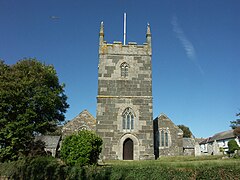Mullion Cliff to Predannack Cliff
Mullion
|
|
|---|---|
 The church of St Mellanus |
|
| Mullion shown within Cornwall | |
| Population | 2,114 (Civil Parish, 2011) |
| OS grid reference | SW678192 |
| Civil parish |
|
| Unitary authority | |
| Ceremonial county | |
| Region | |
| Country | England |
| Sovereign state | United Kingdom |
| Post town | HELSTON |
| Postcode district | TR12 |
| Dialling code | 01326 |
| Police | Devon and Cornwall |
| Fire | Cornwall |
| Ambulance | South Western |
| EU Parliament | South West England |
| UK Parliament | |
Mullion (Cornish: Eglosvelyan) is a civil parish and village on the Lizard Peninsula in south Cornwall, England, United Kingdom. The nearest town is Helston approximately five miles (8 km) to the north.
Mullion civil parish encompasses the church town (now known simply as Mullion) and four smaller settlements: Mullion Cove and Predannack to the southwest; Trewoon and Meaver to the east. Mullion is bordered by the parishes of Gunwalloe and Cury to the north, Grade-Ruan to the east, Landewednack to the south, and by Mount's Bay to the west. The parish also includes Mullion Island, a uninhabited island approximately half a mile (0.8 km) offshore from Mullion Cove. The island is home to large colonies of seabirds and is owned by the National Trust.
The parish name has evolved over the years, with references in the parish records to St Mullyon, St Mullian, Mullian, Mullyan, Mulion, Mullyon and St Mullion. In the Valor Ecclesiasticus carried out in 1535 the village name is recorded as Melyan. The parish takes its name from Saint Melaine, the Breton Bishop of Rennes who supposedly took office in 519. He was a man of many aliases including the Latin version, Saint Melanius. Reference to early publications and the 1908 Ordnance Survey maps show that the parish church was officially known as St Melan's until at least the start of the 20th century. In the late 19th century, Edmund Harvey, Vicar of Mullion, proposed that the parish took its name from 'Mellon' which he believed was an alias of Saint Malo. Saint Malo was a Welshman who moved to Brittany (possibly with his cousin, Saint Samson) where he became Bishop of Aleth (the region now called Saint-Malo) around AD 541. Harvey's ideas have since been discredited. However, an area near one of the ancient chapel sites was known as St Malo's Moor in Harvey's time, and nearby were two fields known as Sampson's Crofts. Mullion was surveyed for the Survey of English Dialects.
...
Wikipedia

